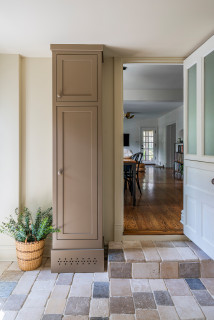
This article was originally published by a www.houzz.com . Read the Original article here. .

This article was originally published by a www.houzz.com . Read the Original article here. .
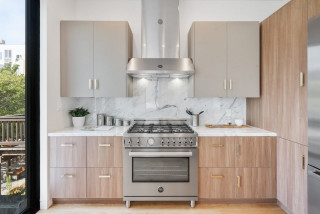
The biggest cost in a kitchen remodel is new cabinets. The most expensive option is custom, in which cabinetry is designed, built and installed to specifically fit your space. Exotic woods, ornate details and period styles add to the cost and delivery time but result in a one-of-a-kind kitchen.
If your budget doesn’t allow for custom, but you need new cabinets, ready-to-assemble cabinetry is a good option. Ready-to-assemble or semicustom cabinets can sometimes be half the cost of custom, depending on the material, style and cost of installation. Semicustom cabinets are selected from existing designs and are prefabricated offsite in standard sizes, with limited size, style, material and finish options.
In-stock cabinets are for customers who want to grab their cabinets right off the shelf and get going. These stock cabinets come in standard sizes, shapes and colors. Since the cabinet dimensions are not based on your kitchen,fillers may be required to make the cabinets fit. These cabinets are very affordable for remodelers on a budget.
Find a general contractor on Houzz
This article was originally published by a www.houzz.com . Read the Original article here. .
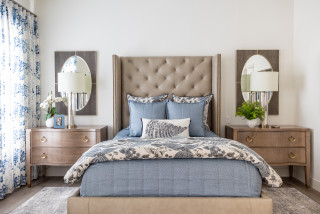
It’s important to remember that potential clients don’t look at just the photos — they’re evaluating the total package. “Everything you put into the world about you and about your work has to be on brand,” Glaister says. “You need to clearly communicate who you are with the images you place on your Houzz profile and the language you use and the tone with which you write about your projects.”
Glaister makes her personality a key part of her brand, which has helped her to attract clients she’ll work well with. “Everything I put on my profile is personal,” she says. “The way that I like to work is woven into the story and shows that I value the family and what we put into the house as a solution. That is just me, and that works for me.”
The team at Bearded Builders follows a similar model, sharing on all its marketing channels the company’s values and what clients can expect during the remodeling process. “We even try to be vulnerable and transparent about the ugly side of remodeling. We want people to get to know us so they know who and what they are getting when they hire us,” Price says. “The brand we have created hopefully reflects our values and company culture, which should attract people who believe in the same things.”
Flavin Architects adds visual treats to its website and Houzz profile, including freehand, artistic design sketches, to reinforce its natural modern brand and to set it apart from other firms. “It’s a handmade quality. It’s approachable for people. It’s becoming a much rarer skill,” Flavin says. “The key is to attract work from clients who have bought into your vision. They naturally are going to allow you to lead the design process.”
For Flavin, attracting the right clients through a strong brand has brought not only a steady stream of leads, but also greater job satisfaction and a more rewarding career. “It sounds so obvious, but we spend so much of a career building a reputation,” he says. “There’s nothing more pleasing than having someone ask for one of your houses. To have that recognition by potential clients.”
This article was originally published by a www.houzz.com . Read the Original article here. .
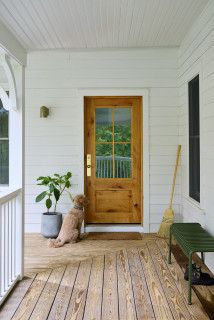
Imagine a guest standing at your front door, waiting for you to answer. What is your porch telling them about what they’ll find inside?
If they’re seeing dirt, dings and cobwebs, the message won’t be a good one. So before adding flowers, furniture or seasonal decor, start with a good scrub. Remove everything and wash every surface, including the front door, windows, light fixtures and railings. Shake out or wash the doormat, touch up chipped paint and replace ripped screens. Even the smallest, humblest porch will feel welcoming — to you and your guest — if it’s clean, tidy and in good repair.
Once your space is clean and uncluttered, you’ll have a clearer sense of whether it needs a simple sprucing-up or calls for a more substantial remodel. For bigger design or construction projects, consider enlisting a pro, many of whom can be found on Houzz.
Find a design-build firm on Houzz
This article was originally published by a www.houzz.com . Read the Original article here. .
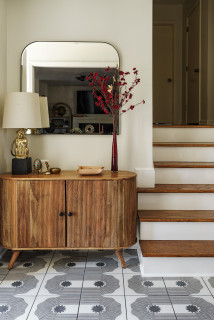
Don’t be afraid to mix and match hook shapes or vary their heights for added interest and functionality — especially in households with children. Just stick to a consistent finish and overall design style to keep the look cohesive, and ensure that no sharp hooks are in anyone’s path of travel.
If you have enough floor space, a coat tree is a charming, freestanding and tool-free alternative to coat hooks — perfect for renters, the drill-averse and homes with brick or plaster walls. Choose one with a wide base for stability.
This article was originally published by a www.houzz.com . Read the Original article here. .
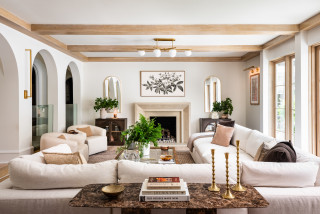
Renovations can be costly, long and disruptive, so it’s no wonder clients can sometimes feel apprehensive and anxious about the progress of a project. Keeping the process on schedule, maintaining the quality of the design and workmanship, and tracking the budget are all essential for ensuring a stress-free project, but communication skills are also vital if you want your client to feel satisfied throughout. Here, professionals on Houzz share their proven tips for keeping customers happy.
The relationship with your client is a two-way process. They are looking to you for guidance, but they also want to be involved. After all, it’s their home being renovated so it’s important you listen to their needs.
“I spend a lot of time at first understanding who they are, their story and their requirements to ensure this is reflected in the design recommendation,” Alexandra Eude of Belle & Cosy says. “I think it’s a true collaboration — even if I often make them step out of their comfort zone — but always remain open to them pushing back.”
10 Questions to Quickly Identify Your Customers’ Needs
For Beth Grace of Start With Art Interiors, the best way to keep clients happy is to outline every step of the process in the initial consultation and proposal. This will get your relationship off on the right foot and establish a feeling of trust.
“Being clear from the beginning avoids any sort of misunderstanding,” Eude says.
Provide as much detail as possible so they know what to expect at each stage of the process. It’s also a good idea to lay out the possible pitfalls ahead of time, as well as things they can do themselves to ensure a smooth-running project.
How to Establish Trust and Build Good Relationships With Clients
Online software provides an efficient way of communicating with customers so they always feel on top of things during the whole renovation process. For a comprehensive way of sharing information, try Houzz Pro’s Client Dashboard. All information about the project will be stored on the dashboard and clients can access the information whenever they like.
Learn about Houzz Pro all-in-one business software
Sharing good news with customers is easy, but what if things aren’t going according to plan? Well, it’s just as important to share that too.
“The best way to keep your clients happy is by always being transparent with them, even when things are not going the way you anticipated,” says interior designer Ann Cope.
Interior designer Lindsey Higgins says: “One of my company values is all about being open and real. So if I sense a client is unhappy or feeling the pressure of their build, I check in specifically and ask. It’s much better to address something than leave it. That way, clients often get the reassurance they need. Address it and overcome it is my motto.”
5 Ways to Prepare First-Time Remodelers Before Work Begins
A remodeling project can be hugely stressful for homeowners, and one of the reasons they hire a professional is to take some of that stress away. So it’s important they feel they can trust your judgment throughout the project.
“Most clients want you to be in control of the whole process, bringing them some peace of mind,” says Sebastian Salas Canitrot of Sebastian Salas Studio.
Eude recommends an “organized, structured and timely approach to the project to demonstrate that everything is under control.”
“Turn up when you say you will,” says garden landscape designer Sam Selby. “Meet your anticipated time frames and keep them in the loop throughout the process.”
Your turn: What have you found works for keeping clients happy? Share your tips in the Comments.
More for Pros on Houzz
Read more stories for pros
Browse millions of photos for inspiration
Learn about Houzz Pro software
Talk with your peers in pro-to-pro discussions
This article was originally published by a www.houzz.com . Read the Original article here. .
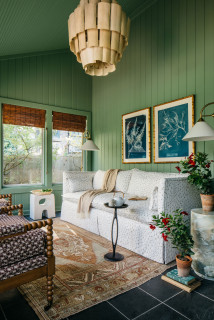
If you have decorative period details in your living room, such as ornately carved cornices, ceiling roses or baseboards, painting these the same color as the walls and ceiling can actually help to highlight them. By taking away the distraction of an abrupt change of color, you’re allowing the texture and detail to shine instead, as demonstrated in this Victorian living room by Born & Bred Studio.
Here, the walls, baseboards, cornices, window frame and wooden shutters have all been drenched in a muted sage green. Adding a large reflective mirror helps to maximize the natural light flowing into the room, allowing light and shadow to play across the surfaces, picking out the details.
How to Confidently Choose Colors for Your Home
This article was originally published by a www.houzz.com . Read the Original article here. .
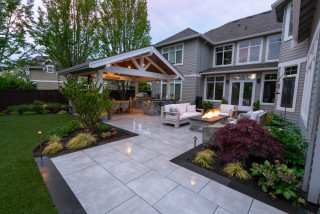
Przygoda-Montgomery, who designed the shaded patio in Oro Valley, Arizona, seen here, says that a way to assess whether your yard is guest-ready is to actually host something. “If people are left standing awkwardly or are unsure where to gather, it’s a sign that the space needs better flow and a better furniture arrangement,” she says.
How to Create an Inviting Outdoor Seating Area
This article was originally published by a www.houzz.com . Read the Original article here. .

Locate your screen in a spot that’s relatively free from adjacent lighting, and set up the projector and sound system. Also, be aware of how your location will affect your neighbors. You don’t want to blast them out with loud sounds or project something unsettling, such as a horror flick, to the neighborhood. Then just add popcorn and enjoy.
10 Etiquette Rules for Outdoor Living
This article was originally published by a www.houzz.com . Read the Original article here. .
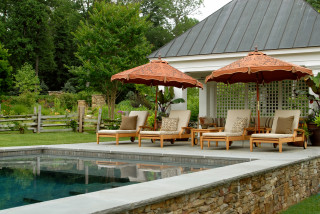
Read on to learn more about some of the fun and unexpected pool options and amenities that can help make the most of your pool. While some of these projects, such as a natural pool, need to be done during initial construction, others, including updating the pool deck or installing a fire feature, can be added to an existing pool.
This article was originally published by a www.houzz.com . Read the Original article here. .
Crown molding, picture rails, wainscoting, hand-hewn banisters and balusters and other decorative trim brought dimension and artisanal flair to older homes. Beyond their beauty, these details often served practical purposes, including concealing imperfect seams and protecting plaster walls from scuffs and dents. While modern materials and construction methods make those functions less necessary, trim and paneling still provide a sense of craftsmanship and permanence that can instantly add character to a new build.
Your home’s architecture offers cues for the decorative trim that will suit it best. Victorians and Colonial Revival moldings tended to be taller and more ornate, for example, whereas Craftsman homes often kept trims simpler and chunkier, with visible joinery. These broader architectural styles can be broken down even further into subsets with their own signature details, so it’s important to be on the same page with your designer or architect about which style you’re after and carry it through the house for consistency.